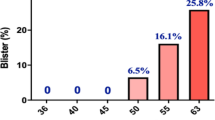Summary
The influence of pharmaceutics with unknown modes of action on an ultraviolet erythema with familiar etiology offers conclusions as to the pharmaceutic's points of operation. Inversely, the influence of pharmaceutics with a known mode of action on erythemas whose pathomechanism is unknown permits insights into the erythemas's etiology.
Based upon these propositions a new precise method for measuring intensities of erythema was developed. The article describes the use of this method in investigating various types of erythemas and the influence of different drugs upon them. The objective measurement of various erythemas was conducted by means of reflectometry. The term “treatment factor” is newly introduced and defined as a quotient of the reflectance of treatment and control fields. The data processing method used to evaluate the individual reflectance values is elaborated. Various possibilities for coordinating control and test fields are illustrated.
Zusammenfassung
Die Beeinflussung eines Ultraviolett-Erythems mit bekannter Pathogenese mit Pharmaka, deren Wirkungsmechanismus uns unbekannt ist, läßt Schlüsse auf deren Angriffspunkte zu. Umgekehrt gestattet die Beeinflussung von Erythemen, deren Pathomechanismus uns bekannt ist, durch Pharmaka mit bekannter Wirkungsweise Einsichten über deren Entstehungsmechanismus.
Aus diesen Gründen wurde ein neues genaues Meßverfahren für Erythemintensitäten zur Untersuchung verschiedener Erythemtypen und deren Beeinflussung durch eine Reihe von Arzneistoffen eingesetzt. Hierbei erfolgt die Objektivierung der Erytheme durch Reflektometrie. Der Begriff des Behandlungsfaktors als eines Quotienten der Remission von Behandlungsfeld und Kontrollfeld wird eingeführt, die rechnerische Verarbeitung der einzelnen Remissionswerte wird dargelegt. Verschiedene Möglichkeiten der Zuordnung von Kontroll- und Testfeldern werden erläutert.
Similar content being viewed by others
References
Baudach H, Schreiber H (1960) Zur Kenntnis des zeitlichen Ablaufs der UV-Reaktion bei Mensch und Kaninchen. Strahlentherapie 111:377–391
Daniels F, Imbrie JD (1958) Comparison between visual grading and reflectance measurements of erythema produced by sunlight. J Invest Dermatol 30:295–304
Daniels F, Van der Leun JC (1968) Problems in quantifying skin reactions. Arch Dermatol 97:553–565
Dixon WJ (ed) (1975) BMDP-Biomedical Computer Programms University of California Press, Berkeley
Eimer E (1978) Varianzanalyse. Kohlhammer, Stuttgart
Greaves MW, McDonald-Gibsen W (1972) Inhibition of prostaglandin biosynthesis by corticosteroids. Br Med J 11:83
Jakobi H, Kadner H, Pinzer B (1977) Der reaktionssuppressive Effekt topischer Corticosteroide beim UV-Erythem. Dermatol Monatsschr 163:970–974
Kölmel K (1976) Ein neues Gerät zur berührungsfreien Erythemmessung. Ärztl Kosmetol 6:135–139
Van der Leun JC (1966) Ultraviolet erythema: a study in diffusion processes in human skin. Thesis, Utrecht
Magnus JA (1976) Dermatological Photobiology. Blackwell, Oxford London
McKenzie AW (1962) Percutaneous absorption of steroids. Arch Dermatol 86:611–614
Parrish JA, Anderson RR, Urbach F, Pitts O (1978) UV. A. Biologic effects of ultraviolet radiation with emphasis on human responses to longwave ultraviolet. Plenum Press, New York London
Reeb O (1962) Grundlagen der Photometrie. In: Naumann H (Hrsg) Bücher der Meßtechnik, Abt III: Messung optischer Größen. Braun, Karlsruhe
Tronnier H (1957) Methodische und apparative Gesichtspunkte zur Messung der menschlichen Hautfarbe. Strahlentherapie 104:146–155
Tronnier H (1967) Vergleich der vasoconstrictorischen und antientzündlichen Wirkung verschiedener Corticosteroide. Proc 13. Cong Int Dermatol München
Warin AP (1968) The Uv-erythemas in man. Br J Dermatol 98:473–477
Weirich EG, Lutz CU (1973) Der Hautvasoconstrictionstest als Prüfmethode für Externcorticoide. Dermatologica 147:353–375
Weirich EG, Lutz CU (1977) Hemmung der Ultraviolettstrahlenreaktion menschlicher Haut durch externe Phologostatica. Arch Dermatol Res 259:49–62
Zaun H (1966) Ist der vasoconstrictionstest zum Vergleich der Wirkungsstärke örtlich applizierter Corticosteroide geeignet. Arch Klin Exp Dermatol 226:359–368
Zaun H, Altmeyer P (1973) Ergebnisse reflexphotometrischer Bestimmungen der Vasoconstriction nach topischer Steroidapplikation. Methode, Aussagekraft, Fehlerquellen. Arch Dermatol Res 247:379–386
Author information
Authors and Affiliations
Rights and permissions
About this article
Cite this article
Kölmel, K., Hünecke, P. A reflectometric method for the standardized evaluation of pharmacological influence on various ultraviolet erythemas. Arch Dermatol Res 268, 261–269 (1980). https://doi.org/10.1007/BF00404287
Received:
Issue Date:
DOI: https://doi.org/10.1007/BF00404287




